Extinction
While Health and especially Finance went full throttle in mobile, driven respectively by pure need and speed, other business markets have been slower to adopt. Yet, this anxious stance does not reflect reality: PC shipments will only be 20.6% of the total market of smart connected devices. Tablets are forecast to overtake PC sales entirely this Christmas. By 2017,total traditional PC devices are expected to drop to 13%, while tablets and smartphones will contribute 16.5% and 70.5% respectively to the overall market. Those that cling towards a PC oriented design strategy will face extinction just as the operating system and software needed to run it.
Man your Stations!
These whispering spirits are often accompanied by the argument: Legal Professionals are different. Legal professionals spend between 40-50 hours on computers. Yet, they spend only 15 hours (30%) on research. Now here’s my question: if 70% on computers is not spent on research, than what are they doing? I presume emailing, drafting,scheduling or reading the news? I haven’t gotten my hands on studies to confirm this. But if so, do you really need a desktop for those “non research” activities?
Read/Write/Research
The answer is No, emailing doesn’t need desktops anymore and drafting is slowly but surely going mobile. This entertaining post asks lawyers to share their iPad home screen. I wasn’t surprised that a word processing app was pinned to their task bar. I can imagine that formatting in MS Word still is a challenge on any screen but its not impossible. Moreover, at the rate of consumer innovation we are just a few swipes away from full-blown word processing on mobile. That leaves us with just those 15 hours chained to desktops (or laptops). Now, why do these voices persist? Because designing legal research is still a challenge on small screens.
Exorcism
Legacy that goes all the way back to the shift from print to online has left walls we cannot see beyond. While the consumer tech broke down barriers and completely conquered businesses to the point of being unethical in some cases. Signs of changing times have shown the wait is almost over. In all corners of Wolters Kluwer we are rethinking and redesigning research on any screen size and in all environments.
FULL DISCLOSURE: I started drafting this post in Simplenote while waiting for my car to get repaired. I copied it to the WordPress app to add links and formatting*. Links I saved while reading the web on my tablet and smartphone in Pocket. No desktops were harmed during the making of this post. So I hereby say farewell to my ghosts.
*Due some technical difficulties and app design issues formatting was finalized on desktop, but at least I tried 🙂













